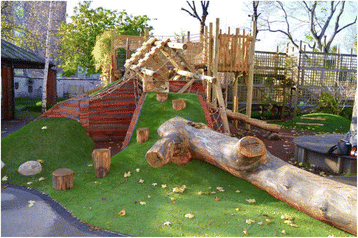Effect of major school playground reconstruction on physical activity and sedentary behaviour: Camden active spaces
- PMID: 28592241
- PMCID: PMC5463303
- DOI: 10.1186/s12889-017-4483-5
Effect of major school playground reconstruction on physical activity and sedentary behaviour: Camden active spaces
Abstract
Background: The physical school environment is a promising setting to increase children's physical activity although robust evidence is sparse. We examined the effects of major playground reconstruction on physical activity and sedentary time in primary schools using a quasi-experimental design (comparison group pre-test/post-test design).
Methods: Five experimental and two control schools from deprived areas of inner city London were recruited at baseline. Main outcome was physical activity and sedentary time measured from objective monitoring (Actigraph accelerometer) at one year follow up. Pupils' impressions of the new playground were qualitatively assessed post construction.
Results: A total of 347 pupils (mean age = 8 years, 55% boys; 36% Caucasian) were recruited into the study at baseline; 303 provided valid baseline Actigraph data. Of those, 231 (76%) completed follow-up (n = 169 intervention; n = 62 control) and 77.4% of the sample recorded at least 4 days of Actigraph wear. In mixed models adjusted for age, sex, ethnicity, ratio activity or sedentary/wear time at baseline, wear time at follow up, and school, no differences were observed in total moderate - vigorous activity (B = -1.4, 95% CI, -7.1, 4.2 min/d), light activity (B = 4.1, 95% CI, -17.9, 26.1), or sedentary time (B = -3.8, 95% CI, -29.2, 21.6 min/d) between groups. There were significant age interactions for sedentary (p = 0.002) and light intensity physical activity (p = 0.008). We observed significant reductions in total sedentary (-28.0, 95% CI, -1.9, -54.1 min/d, p = 0.037) and increases in total light intensity activity (24.6, 95% CI, 0.3, 48.9 min/d, p = 0.047) for children aged under 9 yrs. old in the intervention.
Conclusion: Major playground reconstruction had limited effects on physical activity, but reduced sedentary time was observed in younger children. Qualitative data suggested that the children enjoyed the new playgrounds and experienced a perceived positive change in well-being and social interactions.
Keywords: Active play; Children; Physical activity; Quasi-experimental; School.
Figures
Similar articles
-
Sydney Playground Project: A Cluster-Randomized Trial to Increase Physical Activity, Play, and Social Skills.J Sch Health. 2017 Oct;87(10):751-759. doi: 10.1111/josh.12550. J Sch Health. 2017. PMID: 28876473 Clinical Trial.
-
Camden active spaces: does the construction of active school playgrounds influence children's physical activity levels? A longitudinal quasi-experiment protocol.BMJ Open. 2014;4(8):e005729. doi: 10.1136/bmjopen-2014-005729. BMJ Open. 2014. PMID: 25232566 Free PMC article.
-
The effect of a school-centered multicomponent intervention on daily physical activity and sedentary behavior in primary school children: The Active Living study.Prev Med. 2016 Aug;89:64-69. doi: 10.1016/j.ypmed.2016.05.022. Epub 2016 May 25. Prev Med. 2016. PMID: 27235606
-
The relationship among playground areas and physical activity levels in children.J Pediatr Health Care. 2015 Mar-Apr;29(2):156-68. doi: 10.1016/j.pedhc.2014.10.001. Epub 2014 Nov 20. J Pediatr Health Care. 2015. PMID: 25454386 Review.
-
The role of playgrounds in promoting children's health - a scoping review.Int J Behav Nutr Phys Act. 2024 Jul 8;21(1):72. doi: 10.1186/s12966-024-01618-2. Int J Behav Nutr Phys Act. 2024. PMID: 38978019 Free PMC article.
Cited by
-
A retrospective qualitative evaluation of barriers and facilitators to the implementation of a school-based running programme.BMC Public Health. 2018 Oct 20;18(1):1189. doi: 10.1186/s12889-018-6078-1. BMC Public Health. 2018. PMID: 30342500 Free PMC article.
-
"We just have to work with what we've got": a qualitative analysis of contextual challenges in facilities and resources for pupil physical activity in English primary schools.BMC Public Health. 2025 Feb 21;25(1):726. doi: 10.1186/s12889-025-21895-1. BMC Public Health. 2025. PMID: 39984960 Free PMC article.
-
The Effects of Playground Interventions on Accelerometer-Assessed Physical Activity in Pediatric Populations: A Meta-Analysis.Int J Environ Res Public Health. 2022 Mar 15;19(6):3445. doi: 10.3390/ijerph19063445. Int J Environ Res Public Health. 2022. PMID: 35329132 Free PMC article. Review.
-
Impacts of active school design on school-time sedentary behavior and physical activity: A pilot natural experiment.PLoS One. 2017 Dec 7;12(12):e0189236. doi: 10.1371/journal.pone.0189236. eCollection 2017. PLoS One. 2017. PMID: 29216300 Free PMC article.
-
Physical activity interventions in European primary schools: a scoping review to create a framework for the design of tailored interventions in European countries.Front Public Health. 2024 Feb 8;12:1321167. doi: 10.3389/fpubh.2024.1321167. eCollection 2024. Front Public Health. 2024. PMID: 38389941 Free PMC article.
References
-
- Joint Health Surveys Unit. The Health Survey for England. The Information Centre for Health and Social Care, 2009, Leeds. 2008; www.ic.nhs.uk/pubs/hse08physicalactivity
MeSH terms
LinkOut - more resources
Full Text Sources
Other Literature Sources
Medical


